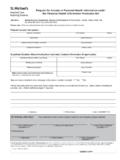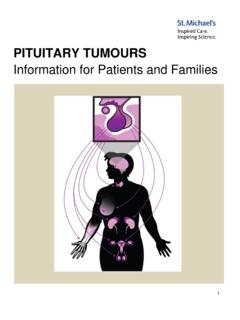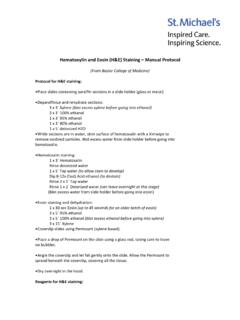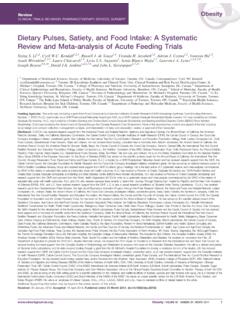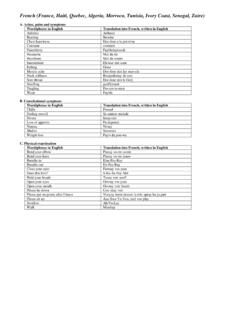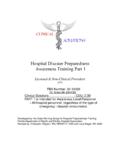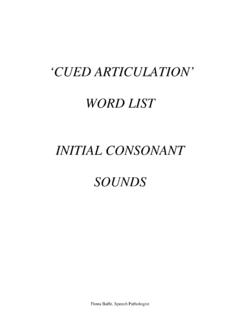Transcription of Mindfulness and the window of tolerance - St. …
1 1 Theme: Mindfulness practice and an understanding of the window of tolerance help us to regulate our is present moment awareness. It means paying attention to our thoughts, emotions, and feelings in the body as they are happening and adopting an attitude of curiosity and compassion. How it HelpsThe practice of mindful awareness can help us to feel better, especially if we are struggling with difficult emotions, fluctuations in our mood or physical pain. It is a skill of stepping into a mode of being present with whatever is happening, rather than reacting and getting stuck on teaches us to.
2 Be more present and engaged in everyday life, rather than being lost in thoughts about the past or worry about the future Step out of autopilot so we can be more purposeful in our day-to-day choices Notice our direct experiences (body sensations, emotions, thoughts) whether they be pleasant, unpleasant or neutral Regulate emotions and ride the waves of their intensity Learn to respond rather than react to or avoid difficulties Relate to ourselves and others with kindness, warmth and compassionThe window of tolerance The window of tolerance (Ogden, et al.)
3 (2006); Siegel, 1999) is the optimal zone of arousal where we are able to manage and thrive in every day life. This can be thought of as sailing within a river of well-being (Siegel & Bryson, 2012) where we are able to respond to all that comes our way without getting thrown off course. When we are outside of our window of tolerance , our nervous system responds by going into survival mode fight, flight or freeze. We can either feel overwhelmed and go into hyper-arousal or we can shut down and go into hypo-arousal. Our window of tolerance can be narrow or wide and is different for all people and at different times in our lives.
4 We can t direct the wind, but we can adjust the sails. thomas s. monsonMindfulness and The window of 1 SESSION 1: Mindfulness & THE window OF we are able to widen our window of tolerance , we can enjoy more smooth sailing regardless of the waves, obstacles and adventures we and The window of ToleranceEmotion regulation depends on our ability to be mindful of fluctuations in our level of arousal and to respond wisely. By becoming aware of body sensations, thoughts and emotions, we can learn to recognize when we are in our optimal zone of arousal or going into hyper or hypo-arousal.
5 Mindfulness gives us skills to: Enjoy when we our sailing within our river of well-being Notice when we are heading into rough waters and steer us back on course Recognize when were in the danger zone and bring ourselves back to safety through grounding skillsGrounding SkillsGrounding skills can serve as a life preserver in those moments of extreme distress. Use these skills to help bring yourself back into the window of tolerance :Hypo-ArousalNumb, no feelings or energy, can t think, shut down, ashamed, disconnected, depression, of tolerance OPTIMAL AROUSAL ZONEC arrying on with daily life in the river of well-being Hyper-Arousal Emotional overwhelm, panic, feeling unsafe, angry, racing thoughts, anxiety, SailingOnce you have gone outside your window of tolerance , you need to recover.
6 This is where Grounding Skills help. Take deep breaths; extend your exhale Release gripped hands Stand tall; feel the ground beneath you Take a brief walk Notice your feet connecting with the floor Orient to and label objects in the room Listen to a song you enjoy Call a friend you trustSESSION 1: Mindfulness & THE window OF & PracticesEating MindfullyEating mindfully involves bringing moment-to-moment awareness to our food as we are eating. Not only will we more fully taste our food, we are also stepping out of autopilot mode and into the As you eat your food, be as curious as you can to find out as much information about it.
7 Using all of your senses, fully explore your food. a. What colours, textures, patterns, etc. can you see? b. What textures can you notice? Is it crunchy or soft? c. What do you notice about how the food smells?d. Does the food make any sounds as you are eating?2. Next, place the food in your mouth and roll it around to all sides with your tongue, noticing how it tastes and feels in your Take a moment to reflect on all that you discovered. The 3-Minute Breathing Space The breathing space provides a way to step out of automatic pilot mode and reconnect with the present moment.
8 The key skill in Mindfulness practice is to maintain awareness in the moment. Nothing else. To remember the three steps of the Three Minute Breathing Space Practice, you can use the acronym AGE: Awareness, Gathering, the field of your awareness around your breathing, so that it includes a sense of the body as a whole, your posture, and facial expression. Then, gently redirect full attention to breathing, to each inbreath and to each outbreath as they follow, one after the yourself into the present moment by deliberately adopting an erect and dignified posture.
9 If possible, close your eyes. Then ask: What is my experience right now in thoughts, feelings and bodily sensations? Acknowledge and register your experience, even if it is , P., Minton, K., and Pain, C. (2006). Trauma and the body: A sensorimotor approach to psychotherapy. New York: , (1999). The developing mind: How relationships and the brain interact to shape who we are. New York; Guilford , Z. V., Williams, J. M. G., & Teasdale, J. D. (2013). Mindfulness -based cognitive therapy for depression: A new approach to preventing relapse. 2nd Edition.
10 New York: Guilford to try: Mindfulness of the senses (track 1) 3-minute breathing space (track 2)SPONSORED BY:Mindful Awareness Stabilization
